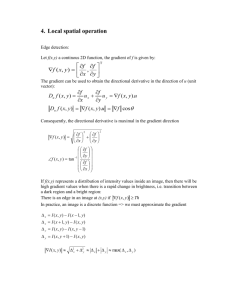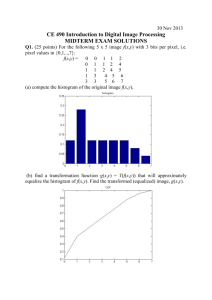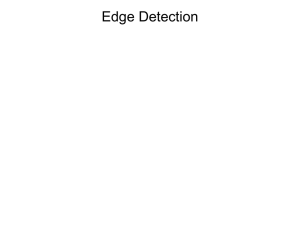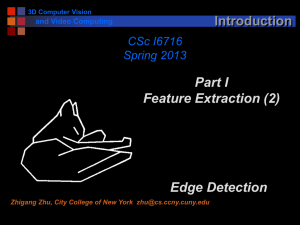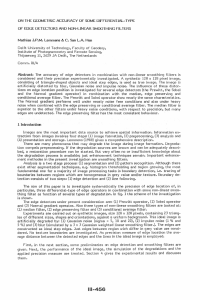Lecture 8: Edge Detection
advertisement
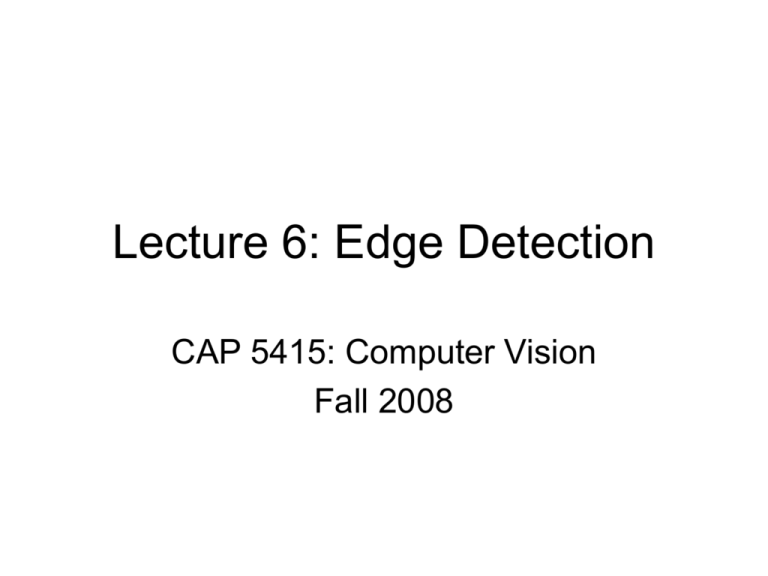
Lecture 6: Edge Detection
CAP 5415: Computer Vision
Fall 2008
Announcements
• PS 2 is available
• Please read it by Thursday
• During Thursday lecture, I will be going
over it in some detail
• Monday - Computer Vision Distinguished
Lecturer series
Edge Detection
“Nonetheless, experience building vision systems suggests that very often,
interesting things are happening in an image at an edge and it is worth
knowing where the edges are.” – Forsyth and Ponce in “Computer VisionA Modern Approach
Simplest Strategy
• Calculate the magnitude of the image
gradient
• Compare against a threshold
Problems
• We get thick edges
• Redundant, especially if we going to be
searching in places where edges are
found
Solution
• Identify the local maximums
• Called “non-maximal suppression”
Basic Idea
• The gradient will be perpendicular to the edge
• Search along the gradient for the maximum point
(From Slides by Forsyth)
Implementation
• Quantize the gradient orientation to a fixed
number of orientations
• Search along those lines in a window
around points above a threshold
(From Course Notes by Shah)
Comparison
Gradient Thresholding
With non-maximal suppression
Avoiding Non-Maximal Suppression
• Can we formulate the problem so we can
eliminate non-maximal suppression?
• Remember: we want to find the maxima
and minima of the gradient
• Look for places where 2nd derivative is
zero
• Called zero-crossings (you may not see
the 2nd derivative actually be zero)
Finding Zero-Crossings
• The second derivative is directional, but
we can us the Laplacian which is
rotationally invariant
• The image is usually smoothed first to
eliminate noise
• Computing Laplacian after filtering with a
Gaussian is equivalent to convolving with
a Laplacian of a Gaussian
The Laplacian of Gaussian
• Sometimes called a
center-surround filter
• Response is similar to
the response of some
neurons in the visual
cortex
Implementation
• Filter with Laplacian of Gaussian
• Look for patterns like {+,0,-} or {+,-}
• Also known as the Marr-Hildreth Edge
Detector
Disadvantages
• Behaves poorly at corners
(From Slides by Forsyth)
Noise and Edge Detection
• Noise is a bad thing for edge-detection
– Usually assume that noise is white Gaussian
noise (not likely in reality!)
• Introduces many spurious edges
• Low-pass filtering is a simple way of
reducing the noise
– For the Laplacian of Gaussian Method, it is
integrated into the edge detection
Why does filtering with a Gaussian
reduce noise?
• Forsyth and Ponce’s explanation:
“Secondly, pixels will have a greater tendency to look like neighbouring pixels — if
we take stationary additive Gaussian noise, and smooth it, the pixel values of the
resulting signal are no longer independent. In some sense, this is what smoothing
was about — recall we introduced smoothing as a method to predict a pixel’s
value from the values of its neighbours. However, if pixels tend to look like their
neighbours, then derivatives must be smaller (because they measure the tendency
of pixels to look different from their neighbours).”
– from Computer Vision – A Modern Approach
How I like to see it
• If F is the DFT of an image, then |F|2 is the
power at each frequency
for i=1:10000
cimg=randn(128);
cum=cum+abs(fft2(cimg)).^2;
end
• In the average power image, the power is
equal at every frequency
Remember: Energy in Images is
concentrated in low-frequencies
Log-Spectrum of the Einstein Image
• When you low-pass filter, you’re retaining the
relatively important low-frequencies and
eliminating the noise in the high frequencies,
where you don’t expect much image energy
Smoothing Fast
• The Gaussian Filter is a separable filter
*
=
• The 2D filter can be expressed as a series of 2
1D convolutions
• For a 9x9 filter, a separable filter requires 18
computations versus 81 for the 2D filter
Further Improvements to the
Gradient Edge-Dector
• Fundamental Steps in Gradient-Based
Edge Dection that we have talked about:
– Smooth to reduce noise
– Compute Gradients
– Do Non-maximal suppression
• There is one more heuristic that we can
advantage of.
• Edges tend to be continuous
Hysteresis Thresholding
• Edges tend to be continuous
• Still threshold the gradient
• Use a lower threshold if a neighboring
point is an edge
• The “Canny Edge Detector” uses all of
these heuristics
Is there better information than the
gradient?
• Martin, Fowlkes,
and Malik
gathered a set of
human
segmentations
From Martin, Fowlkes, and Malik (2004)
Capturing Texture
Texture and Color Help
• This is a precisionrecall curve
Interesting Side-note
• The edge-detector
was a classifier
• The type of classifier
didn’t matter for this
task
• Next Time:
– Fitting Lines to Edge Points
– Binary Operations
